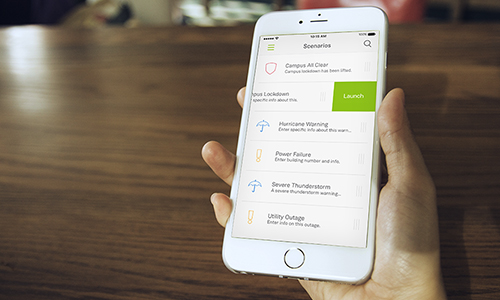Often, when responding to a safety incident, there is no second chance. That’s why it is critical to the safety of your people that emergency communications are free from error — and happen in a timely, concise manner. Nobody should be harmed for lack of accurate and timely information. So, how can you reduce that critical period of time — from recognizing an actionable incident to initiating a comprehensive set of response actions? How can you ensure that the right people receive the right information in a matter of minutes – or even seconds? Automation.
Automating Initiation of Actions
Every day, we are seeing new systems brought to market that autonomously monitor various environmental factors ranging from network threats, severe weather, air quality, and other safety-related conditions. If a life-safety factor is detected, that system can trigger a pre-defined series of actions in a suitably equipped emergency notification system. This can significantly reduce the time to initiate (TTI), resulting in a greater likelihood of minimizing the harm caused by the identified threat.
The process of automating emergency notifications involves pre-defining actions that need to occur if and when an emergency happens. Each possible scenario (e.g., lockdown, severe weather warning, HAZMAT, active shooter, etc.) should have a thoughtfully crafted sequence of actions that can be set into motion with a single initiation. As these actions are typically an extension of the organization’s existing emergency response plans, it is recommended that they be implemented collaboratively.
Reducing the Time to Initiate
By automating, the time to initiate and deploy mass notifications is dramatically reduced. Since each message has already been carefully crafted for each constituent group and multimodal endpoint, it is not necessary to spend extra time deciphering – often in the midst of an unfolding crisis — what to communicate and where it should go. This saves valuable time when it counts and significantly mitigates the risk of miscommunication.
In addition to directing emergency notifications, this first set of automated actions should also be used to initiate the mobilization of first response resources. Being able to expediently request EMT/ambulance, fire, and local law enforcement has shown to significantly improve victim outcomes if physical harm is an incidental factor.
Automation also reduces the time to initiate a real-time collaboration session with a predefined group in order to make administrative and executive decisions during the incident. Automation should be used to help establish an instant, remote unified command to monitor a situation, discuss next steps, coordinate resources, and more.
Providing Concise Information
An emergency mass notification must provide clear, actionable information. The challenge is quickly determining — while under duress — who receives what information via which method. The predecessor to an automated approach was to create pre-scripted message “templates.” This was effective in accurately sending one message to the masses, but required the selection of which group should receive the notification. Automation adds sophistication to templates by establishing multiple communications loops for different recipients and modalities.
Invariably, we have heard stories of mass notifications that have been compromised by the adrenaline-fueled haste of the individual or organizations sending the alerts. In some cases, the wrong people receive incorrect notifications, incorrect groups can be selected, messages can contain typographical errors, actionable information can be left out, etc. … The possibilities for error go on.
John Hauser, Safety Manager at University of Nebraska Medical Center, shares, “Automation makes life easier for the dispatchers and reduces the chance of making a mistake. You do not have to worry that a group will be missed because the dispatcher was distracted or does not have time to verify. ”
Automation can significantly mitigate the risk for human error since the sequence of actions, including messages, have been thought out, vetted, and predefined well before the incident occurs.
To learn more on how University of Nebraska Medical Center uses automation to respond to safety situations, visit: https://www.omnilert.com/get-critical-mass-unmc.














